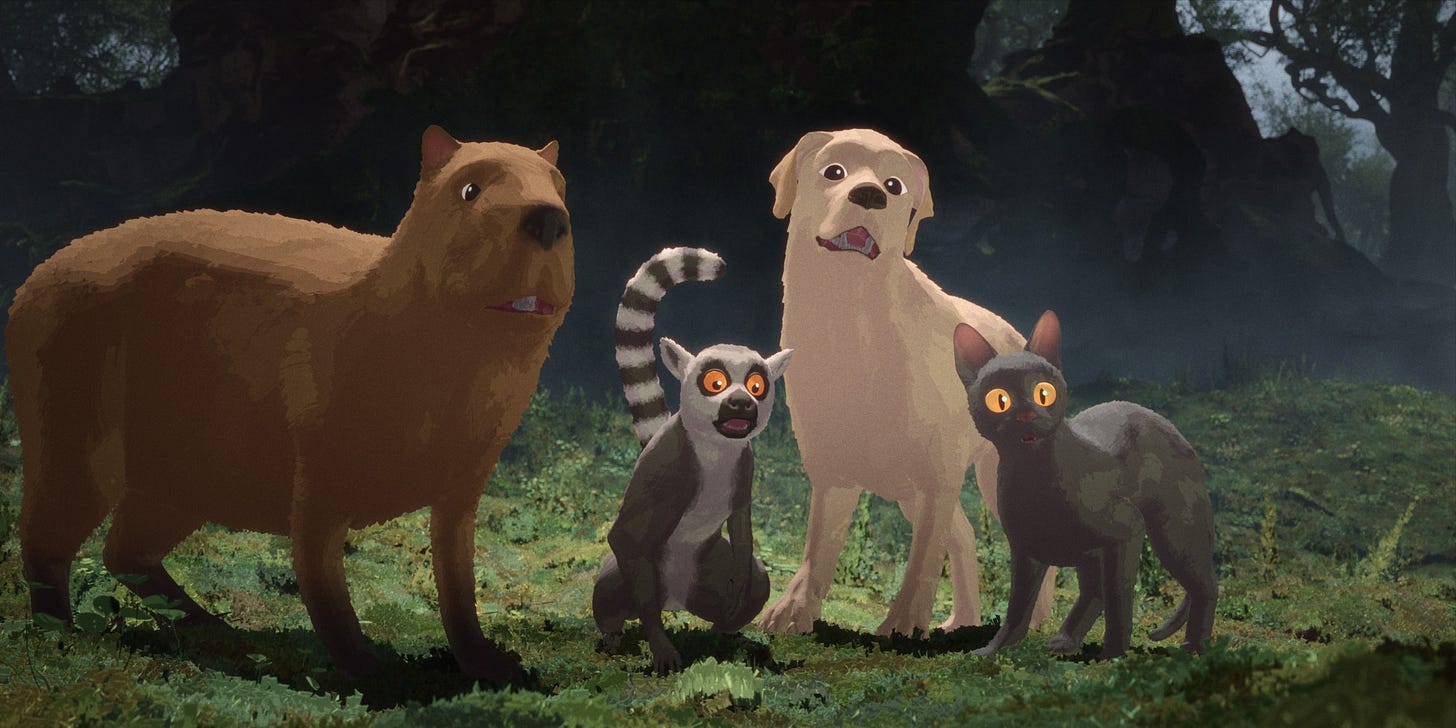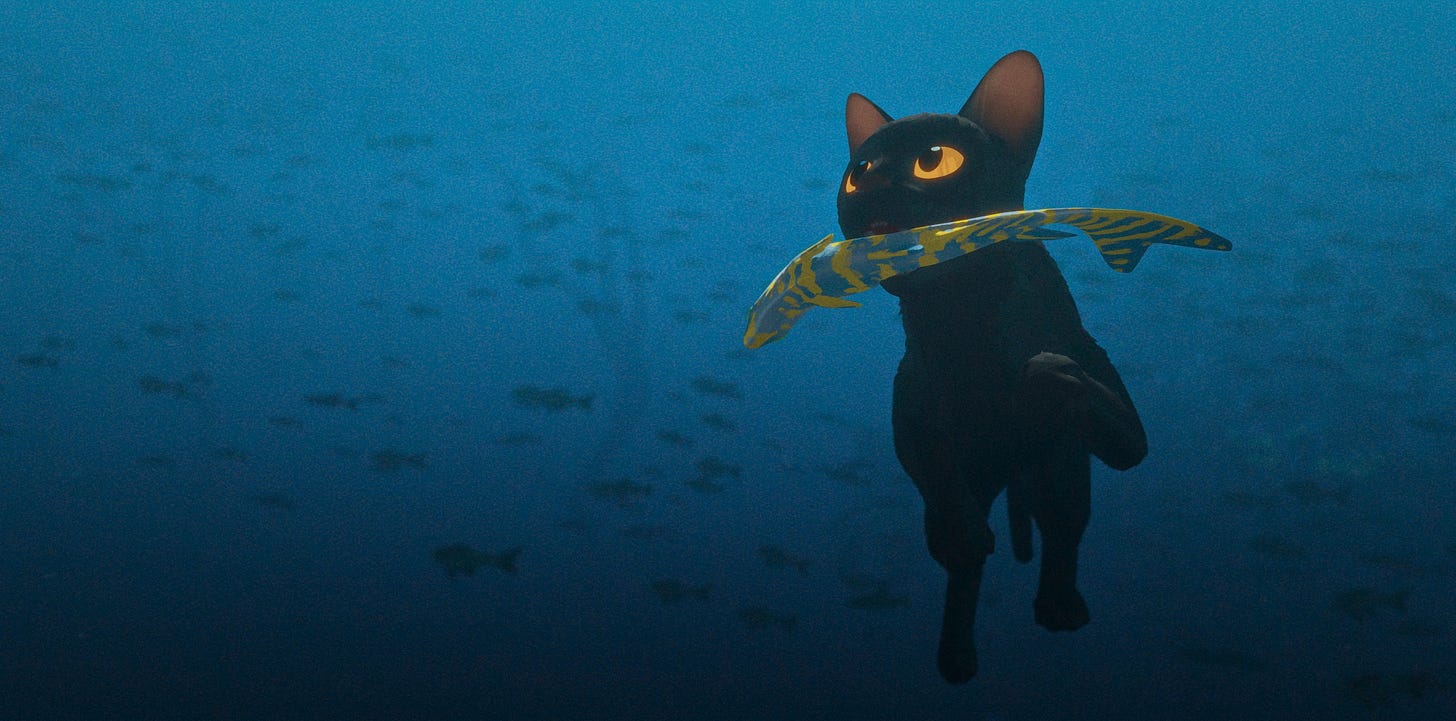Flow: An Animated Masterpiece with Subtle Lessons for Leaders and Teams
Gints Zilbalodis's animated feature "Flow" offers deep learnings for working life. Also… adorable animals.

To develop the traits needed for leadership and teamwork, we should immerse ourselves in art, especially storytelling in the forms of fiction, audio, and video.
Art doesn’t offer easy answers, but it can foster empathy, self-awareness, wisdom, authenticity, resilience, emotional intelligence, and inclusiveness — traits typically associated with transformational leadership and team success.
Case in point: Flow.
The animated feature Flow, which won Academy Awards for best animated feature film and best international feature film, was the most extraordinary film I watched in 2024… and, possibly, ever. Watch a trailer.
While the film first and foremost is an emotional delight, suitable for all ages, its thematic elements of teamwork, leadership, and personality are no accident.
The Flow Storyline
[Possible semi-spoiler alert]
In an epic flood, a cat finds itself adrift on a boat with a diverse group of animals — a golden retriever, lemur, secretary bird, and capybara. With no dialog, but plentiful communication, they navigate the high waters through a timeless world that seems to straddle fantasy and reality.
If you haven’t seen Flow yet, I’m sure you’ll love it for its beauty and its heart.
Beyond its deeply moving aesthetic and emotional qualities, however, Flow stands as a meditation on teamwork and leadership. This is not just my interpretation. In an interview, Latvian director Gints Zilbalodis recounts how the plotline of the film follows his real-time experience as he transitioned from being a solo animator to team leader:
“It’s the first time I’m working with a team; I used to do films just by myself. I had to learn how to work together in a team, just like the cat. It’s kind of a story about making the film itself.”
The film is not trying to teach anything; it doesn’t have a message. It’s a masterwork of feelings and awe.
That said, those open to reflection can find in Flow a nuanced, visceral understanding of collaboration that transcends conventional leadership content.
Takeaways for Leaders and Teams
The ways in which artworks foster personal growth defy simple categorization. Yet for readers seeking a framework — we are, after all, conditioned to revere practicality — I offer these surface-level insights as an entry point to deeper understanding.
• Collaboration: A theme of Flow revolves around the necessity of teamwork for surviving adversity. Even independent personalities can benefit from, and sometimes require, the strengths and perspectives of others to overcome challenges.
• Trust: The cat’s journey involves overcoming its fear of others and learning to trust its new companions. Trust, the film shows us, allows for better communication, shared responsibility, and mutual support.
• Diverse Strengths: The animals each possess unique abilities that contribute to their collective survival. A diverse team, where individual strengths are valued and utilized, can be more resilient and successful.
• Belonging and Authenticity: The animals in Flow are different species with varying personalities, yet they learn to accept each other and work together. An inclusive environment, where team members feel accepted for who they are, fosters team cohesion.
• Adaptive Leadership: While there isn’t a clear leader in Flow, different animals take charge in different ways, depending on the circumstances. Leadership can be fluid and emerge based on the needs and the strengths of individuals within the team.
• Non-Verbal Communication: The animals communicate through body language, behavior, and sounds. This underscores the importance of paying attention to non-verbal cues, active listening, and understanding the unspoken needs and feelings of team members.
• The Greater Good: The cat overcomes its fear of water to survive and eventually help others. Similarly, in a work environment, team members may need to step outside their comfort zones and confront personal challenges for the benefit of the group.
• Shared Purpose: The animals in Flow are united by the common goal of survival. A clear and compelling shared purpose is crucial to align team efforts and motivate collaborative work.
• Adaptability and Resilience: The animals face unexpected challenges. Their ability to go with the flow as a team is crucial for their survival, highlighting the importance of adaptability and resilience.
Balance: Overcoming and Accepting
The cat goes from being a loner to being more of a team player, as the dog becomes more independent and confident. But Zilbalodis avoids favoring one personality type over another. If anything, the animals exemplify authenticity and acceptance. Zilbalodis says:
Even though we leave some things ambiguous about the world, it’s important that it’s definitive what happens to the characters. How they change, how they learn. Everything was built around the cat’s journey of not just overcoming its fears of water or fear of others but learning how to live with these fears, and accepting them. I didn’t want to have this didactic simple message that being independent is bad and working together is good. We also have this dog character who is on this opposite journey as the cat. In the beginning he’s very trustful of others and always wants someone to tell them what to do… Throughout the journey the dog learns how to be more independent. It was important to show that the truth is somewhere in the middle.
Art Opens the Floodgates
In one thrilling scene, the dog, lemur, and capybara push back on the secretary bird’s chosen direction. The cat intervenes by resisting an ally. The subsequent events are perilous. This sequence leaves me pondering new perspectives on leadership style, loyalty, psychological safety, and passive aggressiveness.
But Flow proposes no easy answers. It won’t make us perfect managers or transform our working lives overnight.
Over time, however, immersing ourselves in art and storytelling can, I believe, help us grow in ways unachievable by the conventional modes of learning continuously marketed to us.
As a final thought, I leave you with this all-important quote from Zilbalodis’s Academy Award acceptance speech:
We are all on the same boat, and we must find ways to overcome our differences and work together.








